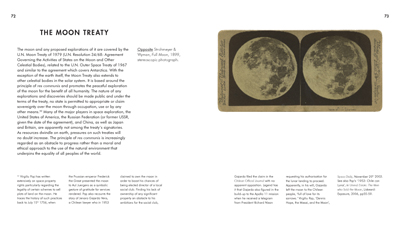![]()
![]()
![]()
![]()
![]()
...
...
...
Accidental
Journey
The Observatory
The Flag Story
Far side
Moon Treaty
Proviso
[click on the image to progress]
The nature of any explorations and discoveries should be made public and under the terms of the treaty, no state is permitted to appropriate or claim sovereignty over the moon through occupation, use or by any other means. Many of the major players in space exploration, the United States of America, the Russian Federation (or former USSR, given the date of the agreement), and China, as well as Japan and Britain, are apparently not among the treaty's signatories.
As resources dwindle on earth, pressures on such treaties will no doubt increase. The principle of res communis is increasingly regarded as an obstacle to progress rather than a moral and ethical approach to the use of the natural environment that underpins the equality of all peoples of the world.

